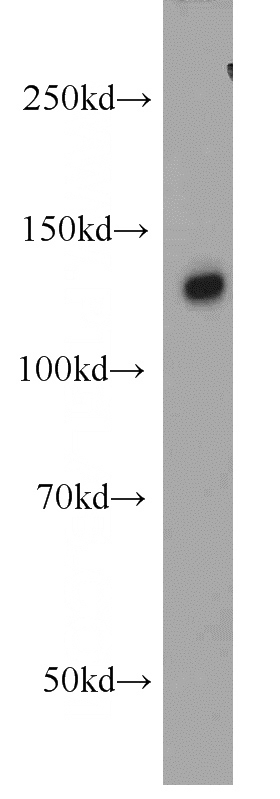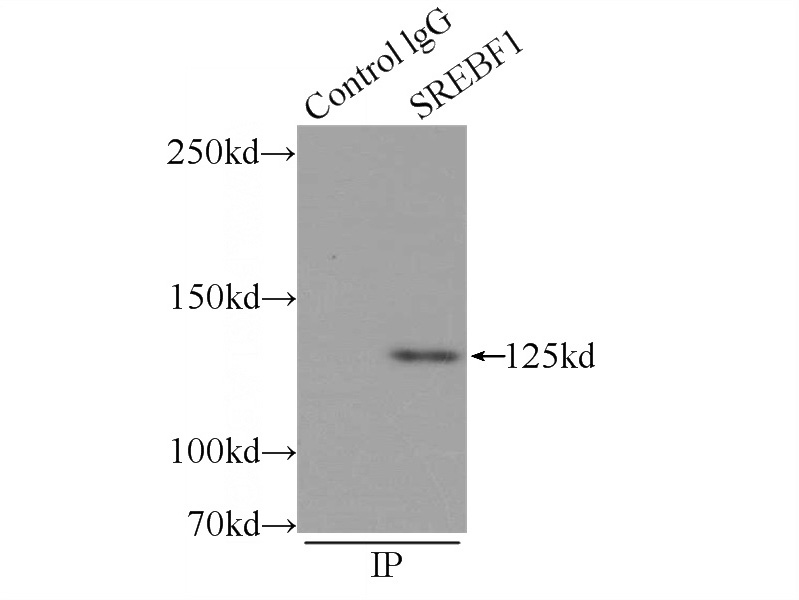-
Product Name
SREBF1 antibody
- Documents
-
Description
SREBF1 Rabbit Polyclonal antibody. Positive WB detected in HeLa cells, L02 cells. Positive IP detected in L02 cells. Observed molecular weight by Western-blot: 125kd
-
Tested applications
ELISA, WB, IP
-
Species reactivity
Human, Mouse; other species not tested.
-
Alternative names
bHLHd1 antibody; SREBF1 antibody; SREBP 1 antibody; SREBP 1c antibody; SREBP1 antibody
-
Isotype
Rabbit IgG
-
Preparation
This antibody was obtained by immunization of SREBF1 recombinant protein (Accession Number: NM_001005291). Purification method: Antigen affinity purified.
-
Clonality
Polyclonal
-
Formulation
PBS with 0.02% sodium azide and 50% glycerol pH 7.3.
-
Storage instructions
Store at -20℃. DO NOT ALIQUOT
-
Applications
Recommended Dilution:
WB: 1:200-1:2000
IP: 1:200-1:2000
-
Validations

HeLa cells were subjected to SDS PAGE followed by western blot with Catalog No:115669(SREBF1 antibody) at dilution of 1:500

IP Result of anti-SREBF1 (IP:Catalog No:115669, 4ug; Detection:Catalog No:115669 1:600) with L02 cells lysate 1500ug.
-
Background
SREBF1, also named as BHLHD1 and SREBP1, contains one basic helix-loop-helix (bHLH) domain and belongs to the SREBP family. It is a transcriptional activator required for lipid homeostasis. The SREBPs are synthesized as precursors anchored to endoplasmic reticulum (ER) membranes and complexed with SCAP. When the cellular cholesterol level is low, SREBP-SCAP complexes move to the Golgi apparatus, where SREBPs undergo a two-step proteolytic processing, leading to the release of the mature form, an N-terminal fragment, i.e, basic helix-loop-helix leucine zipper transcription factor. These factors enter the nucleus where they bind to sterol regulatory elements (SRE) in the promoter regions of a number of genes whose products mediate the synthesis of cholesterol and fatty acids. [PMID: 21698267]. This antibody can recognize the 125kd precursor form and the 68kd mature form of human SREBF1.
-
References
- Zhou T, Li S, Zhong W. OSBP-related protein 8 (ORP8) regulates plasma and liver tissue lipid levels and interacts with the nucleoporin Nup62. PloS one. 6(6):e21078. 2011.
- Hu YW, Ma X, Huang JL. Dihydrocapsaicin Attenuates Plaque Formation through a PPARγ/LXRα Pathway in apoE(-/-) Mice Fed a High-Fat/High-Cholesterol Diet. PloS one. 8(6):e66876. 2013.
- Hu YW, Yang JY, Ma X. A lincRNA-DYNLRB2-2/GPR119/GLP-1R/ABCA1-dependent signal transduction pathway is essential for the regulation of cholesterol homeostasis. Journal of lipid research. 55(4):681-97. 2014.
- Ding SY, Lee MJ, Summer R, Liu L, Fried SK, Pilch PF. Pleiotropic effects of cavin-1 deficiency on lipid metabolism. The Journal of biological chemistry. 289(12):8473-83. 2014.
- Hu YW, Zhao JY, Li SF. RP5-833A20.1/miR-382-5p/NFIA-dependent signal transduction pathway contributes to the regulation of cholesterol homeostasis and inflammatory reaction. Arteriosclerosis, thrombosis, and vascular biology. 35(1):87-101. 2015.
- Chiu CY, Chan IL, Yang TH, Liu SH, Chiang MT. Supplementation of chitosan alleviates high-fat diet-enhanced lipogenesis in rats via adenosine monophosphate (AMP)-activated protein kinase activation and inhibition of lipogenesis-associated genes. Journal of agricultural and food chemistry. 63(11):2979-88. 2015.
- Ji S, Qin Y, Shi S. ERK kinase phosphorylates and destabilizes the tumor suppressor FBW7 in pancreatic cancer. Cell research. 25(5):561-73. 2015.
- Cui M, Xiao Z, Wang Y. Long noncoding RNA HULC modulates abnormal lipid metabolism in hepatoma cells through an miR-9-mediated RXRA signaling pathway. Cancer research. 75(5):846-57. 2015.
Related Products / Services
Please note: All products are "FOR RESEARCH USE ONLY AND ARE NOT INTENDED FOR DIAGNOSTIC OR THERAPEUTIC USE"
